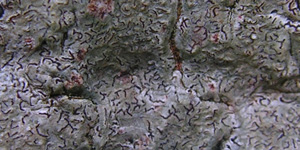Cladonia cyathomorpha in the New Forest
Cladonia cyathomorpha is a nationally scarce Pixie Cup Cladonia of humid shady places, on mossy rocks in the west. In Europe it has also been recorded on the bases of old trees. The description in the recent Nordic Lichen Flora (NLF) differs from that in The Lichens Of Great Britain and Ireland (LGBI). The former describes the veins on the undersides of the squamules being white and only sometimes coloured orange-brown at the base and not wholly pinkish as implied in the LBGI, while the K spot test is given as K – not K + yellow. After finding material matching the NLF description in several locations in the south west of England, where it has been rarely recorded, I thought it would be worth looking for it in the New Forest. The late Francis Rose had pointed out to me in the 1990s that there seemed to be distinct Pixie Cup with large squamules in old woods in the New Forest, which it now occurred to me might be Cladonia cyathomorpha. I had found some scrappy material which appeared to be Cladonia cyathomorpha on the base of an old Beech in Mark Ash Wood on the 8th December 2013 but needed to find better material before being convinced.
(BLS data from the NBN)
Andy Cross and I had an afternoon walk in the New Forest on Saturday 11th January 2014, with the aim of starting to record an isolated heathland square north of Berry Wood (SU2106). This involved walking through rich ancient Beech - Pedunclate Oak - Holly pasture woodland before reaching the heath. After doing 1km without looking at a lichen to get to the wood, we checked the best looking trees as we went through.
One good target I spotted was a long fallen big Beech trunk that was in a nice state of decay. This habitat supports a good mix of Cladonia species, which is usually more diverse than the assemblage on Oak trunks. This produced exactly what I was looking for; a massive colony of Cladonia cyathomorpha.
Cladonia cyathomorpha site
This had nice big basal squamules, with clear white veining on the undersides, which became orange-brown and even very slightly pinkish at the base of the largest squamules. Most of the podetia were typical with simple cups, with smooth podetia stalks below and corticate granules above, especially inside the cups. Some our material, however, had quite odd baroque poliferations. These were twisted and bifurcated with brown apothecia/pycnidia (these looked like sterile apothecia internally) on the tips. The poliferations do not seem to have been described before and apothecia are described as very rare in the LGBI.
Cladonia cyathomorpha specimen
So I am now happy that Cladonia cyathomorpha is in the New Forest; the first modern records for the lowlands. Cladonia pyxidata appears more frequent on the trees; it has mealy unviened undersides and squamules on the podetia as well as the cups. Cladonia cyathomorpha is probably widespread in the Forest in sheltered humid locations, and must occur elsewhere in the lowlands. There is an old record from the Surrey Weald in the BLS mapping database but with no data attached. It is likely to be a species of old or little disturbed habitats in the lowlands.
Andy was curious what the name meant, so looked it up and it is a compound of cyath - cup and morph – shape. So, a crude translation of its scientific name is the Cup-shaped Cladonia though an actual translation by someone who knew tenses etc would give a more accurate name. Out of all the Cladonia species with cups, why chose this species to carry the name?
I tracked down the original publication: Watson, 1935, J. Bot. 73, 156, link to PDF. It seems the name actually refers to the curled up cup like dry basal squamules, not the the cups on the podetia, so not quite so odd, but still a bit of a herbarium based name, as the lichen is probably rarely that dry in its typical habitats.
Interestingly a tarted up google translation of the latin description produces 'white veins similar to Peltigera but more obscure' from 'subtus albae reagentibus immutatae cum venis Pelligerae similibus', This perfectly describes what I am seeing and there is no mention of the pink veins of the LGBI.
Neil A Sanderson & Andy M Cross 15/1/2014



